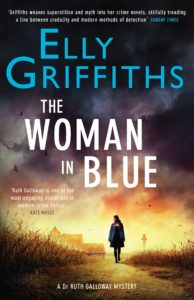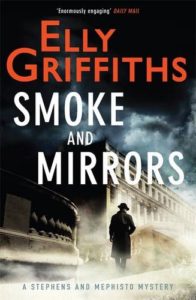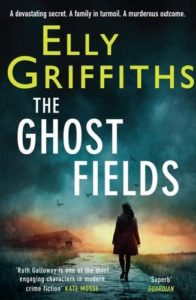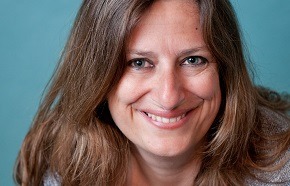Books
Elly Griffiths: The Research Process
My Ruth Galloway books all start with the place. The Crossing Places began with a comment from my husband Andy about how prehistoric people saw marshland as sacred; neither land nor sea, neither life nor death. I got the idea for The Ghost Fields when I was driving through Norfolk lost (this happens a lot) and I came across an abandoned second world war airfield. There was a pub nearby called The Hourglass and I thought of the airmen risking their lives and coming back to drink in a bar that might as well have been named The Grim Reaper. In the course of my research I found out that The Hourglass had actually been called The Horse and Groom during the war. The place had a rather unsavoury reputation so the new owners renamed it whilst keeping the HG initials.
 That’s the thing about research. You start off wanting to know one thing and soon get sidetracked by another. Sometimes the sidetrack is more interesting than the main road, sometimes it’s a cul-de-sac. Sometimes you build a whole plot of some esoteric point and it turns out to be impossible (damn you, acidic soil). Sometimes you desperately want something to be true and it is. When I was researching A Room Full of Bones I decided to include Julian of Norwich, a fourteenth century anchoress and mystic. I wanted something to link Julian to Ruth and thought: what if Julian had a cat? Then, one day in Norwich cathedral, I asked the guide about Mother Julian. ‘Have you seen the window?’ he said. There, in a side chapel, was a stained-glass window immortalising Julian and her beautiful ginger cat, just like Ruth’s beloved Flint. Julian must have loved her cat, I decided, otherwise why go to the trouble of depicting it in costly orange and gold glass?
That’s the thing about research. You start off wanting to know one thing and soon get sidetracked by another. Sometimes the sidetrack is more interesting than the main road, sometimes it’s a cul-de-sac. Sometimes you build a whole plot of some esoteric point and it turns out to be impossible (damn you, acidic soil). Sometimes you desperately want something to be true and it is. When I was researching A Room Full of Bones I decided to include Julian of Norwich, a fourteenth century anchoress and mystic. I wanted something to link Julian to Ruth and thought: what if Julian had a cat? Then, one day in Norwich cathedral, I asked the guide about Mother Julian. ‘Have you seen the window?’ he said. There, in a side chapel, was a stained-glass window immortalising Julian and her beautiful ginger cat, just like Ruth’s beloved Flint. Julian must have loved her cat, I decided, otherwise why go to the trouble of depicting it in costly orange and gold glass?
Once I have the place, I like to visit it. Maps and street finder are all very well but nothing beats actually going to the location, talking to the locals and smelling the air. The Ruth Galloway books are set in Norfolk and so, for the last eight years, Norfolk has been the holiday destination for our family. My children claim that in all that time they have never once seen the sun. But they love the place; we all do. And, statistically, Norfolk is actually one of the sunniest places in Britain. The year I was writing Dying Fall was an exciting one because we got to go to Blackpool instead. In fact, we had a wonderful holiday near the Pendle Hills and an unforgettable day at the pleasure beach. I can honestly say that the most frightening thing I have ever done in the name of research is going on The Big One, Blackpool’s famous roller coaster. It lasted for ten Hail Marys, not that Ruth would ever measure time in that way.
 Researching the Stephens and Mephisto series is very different. The books are mainly set in Brighton, the town where I have lived since I was five. But they are set in the 1950s, which means travelling in time if not in place. The 50s don’t seem that long ago to me. I was born in the 60s but I’m the youngest in my family and my father was born in 1912. It hasn’t been difficult recreating the idiom of the time because that’s how my dad spoke, ‘old boy’ and so on. The books are set in the theatrical world and there my biggest asset has been my grandfather’s collection of old playbills. Granddad was a music hall comedian and I have some of his posters framed in my office. If I ever get stuck, I just look at the names: Lou Lenny and her unridable mule, Raydini the gay deceiver, Levanda’s feats with the feet. You couldn’t make it up. Well, you could but it wouldn’t be the same.
Researching the Stephens and Mephisto series is very different. The books are mainly set in Brighton, the town where I have lived since I was five. But they are set in the 1950s, which means travelling in time if not in place. The 50s don’t seem that long ago to me. I was born in the 60s but I’m the youngest in my family and my father was born in 1912. It hasn’t been difficult recreating the idiom of the time because that’s how my dad spoke, ‘old boy’ and so on. The books are set in the theatrical world and there my biggest asset has been my grandfather’s collection of old playbills. Granddad was a music hall comedian and I have some of his posters framed in my office. If I ever get stuck, I just look at the names: Lou Lenny and her unridable mule, Raydini the gay deceiver, Levanda’s feats with the feet. You couldn’t make it up. Well, you could but it wouldn’t be the same.
The biggest challenge when researching a historical novel is to remember that this wasn’t history to them. My characters wouldn’t have thought, ‘Oh the quaint old fifties’, they would have thought: ‘Wow, what exciting modern times. The end of rationing. The birth of new technology. A new Queen on the throne.’ Another writer gave me a good tip which was to look at old newsreel rather than reference books, because the old films show people actually living in the now rather than in the ‘wasn’t it odd back then’. I also like to read fiction from the era. Monica Dickens, for example, can tell you more in one phrase than you would learn in a whole day of googling ‘Fifties attitudes’. One of my favourite Monica Dickens novels, No More Meadows, starts with a description of the main character, Christine. ‘With the suit, Christine wore a grey felt beret which had been sold to her cheaply by Mrs Arnold in Millinery…’ This tells you that in 1951 women still wore suits and hats, they went  to shops that had millinery departments and were served by assistants with no first names. Some things, on the other hand, never change. Later on we learn that Christine felt safe when she wore this outfit, ‘even when she hazarded the supreme test of catching herself sideways in shop windows, she looked all right’. We’ve all been there, Christine.
to shops that had millinery departments and were served by assistants with no first names. Some things, on the other hand, never change. Later on we learn that Christine felt safe when she wore this outfit, ‘even when she hazarded the supreme test of catching herself sideways in shop windows, she looked all right’. We’ve all been there, Christine.
With crime novels, in particular, readers have come to expect meticulous research. Perhaps because the genre itself demands a certain suspension of disbelief (Another murder? Really?), writers feel that they must make it up to their readers in other ways. Alright, there’s been another killing in this sleepy market town but the forensic details are spot on. I feel that I must get the archaeology as accurate as possible even though it is statistically unlikely that a forensic archaeologist would find herself in danger quite so often. But the research creates what Henry James called ‘solidity of specification’. It might seem surprising that it was Colonel Mustard in the library with the candlestick but your research shows that ninety percent of retired army officers who kill do so in a reading room armed with a Regency gilt-bronze objet d’art (Sotheby’s 1815).
Elly’s new Ruth Galloway novel, The Woman in Blue, publishes on 4th February. We can’t wait!


Please note: Moderation is enabled and may delay your comment being posted. There is no need to resubmit your comment. By posting a comment you are agreeing to the website Terms of Use.